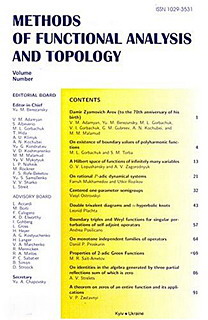Vol. 24 (2018), no. 4
Complex powers of abstract pseudodifferential operators
MFAT 24 (2018), no. 4, 305-338
305-338
Under suitable assumptions, we show that the abstract pseudodifferen\-tial operators introduced by Connes and Moscovici possess complex powers that belong to this class of operators. We analyse several spectral functions obtained via the (super)trace including the zeta function and the heat trace. We present examples showing that the analysis is explicit and tractable.
Automorphisms generated by umbral calculus on a nuclear space of entire test functions
Ferdinand Jamil, Yuri Kondratiev, Sheila Menchavez, Ludwig Streit
MFAT 24 (2018), no. 4, 339-348
339-348
In this paper we show that Sheffer operators, mapping monomials to certain Sheffer polynomial sequences, such as falling and rising factorials, Charlier, and Hermite polynomials extend to continuous automorphisms on the space of entire functions of first order growth and minimal type.
On the Gevrey ultradifferentiability of weak solutions of an abstract evolution equation with a scalar type spectral operator
MFAT 24 (2018), no. 4, 349-369
349-369
Found are conditions on a scalar type spectral operator $A$ in a complex Banach space necessary and sufficient for all weak solutions of the evolution equation \begin{equation*} y'(t)=Ay(t),\quad t\ge 0, \end{equation*} to be strongly Gevrey ultradifferentiable of order $\beta\ge 1$, in particular analytic or entire, on $[0,\infty)$. Certain inherent smoothness improvement effects are analyzed.
Lacunary $\mathcal{I}$-convergent and lacunary $\mathcal{I}$-bounded sequence spaces defined by a Musielak-Orlicz function over $n$-normed spaces
MFAT 24 (2018), no. 4, 370-380
370-380
In the present paper we defined $\mathcal{I}$-convergent and $\mathcal{I}$-bounded sequence spaces defined by a Musielak-Orlicz function $\mathcal{M} = (M_k)$ over $n$-normed spaces. We also make an effort to study some topological properties and prove some inclusion relation between these spaces.
Continuous symmetric 3-homogeneous polynomials on spaces of Lebesgue measurable essentially bounded functions
T. V. Vasylyshyn, A. V. Zagorodnyuk
MFAT 24 (2018), no. 4, 381-398
381-398
Vector spaces of all homogeneous continuous polynomials on infinite dimensional Banach spaces are infinite dimensional. But spaces of homogeneous continuous polynomials with some additional natural properties can be finite dimensional. The so-called symmetry of polynomials on some classes of Banach spaces is one of such properties. In this paper we consider continuous symmetric $3$-homogeneous polynomials on the complex Banach space $L_\infty$ of all Lebesgue measurable essentially bounded complex-valued functions on $[0,1]$ and on the Cartesian square of this space. We construct Hamel bases of spaces of such polynomials and prove formulas for representing of polynomials as linear combinations of base polynomials. Results of the paper can be used for investigations of algebras of symmetric continuous polynomials and of symmetric analytic functions on $L_\infty$ and on its Cartesian square. In particular, in order to describe appropriate topologies on the spectrum (the set of complex valued homomorphisms) of a given algebra of analytic functions, it is useful to have representations for polynomials, obtained in this paper.


